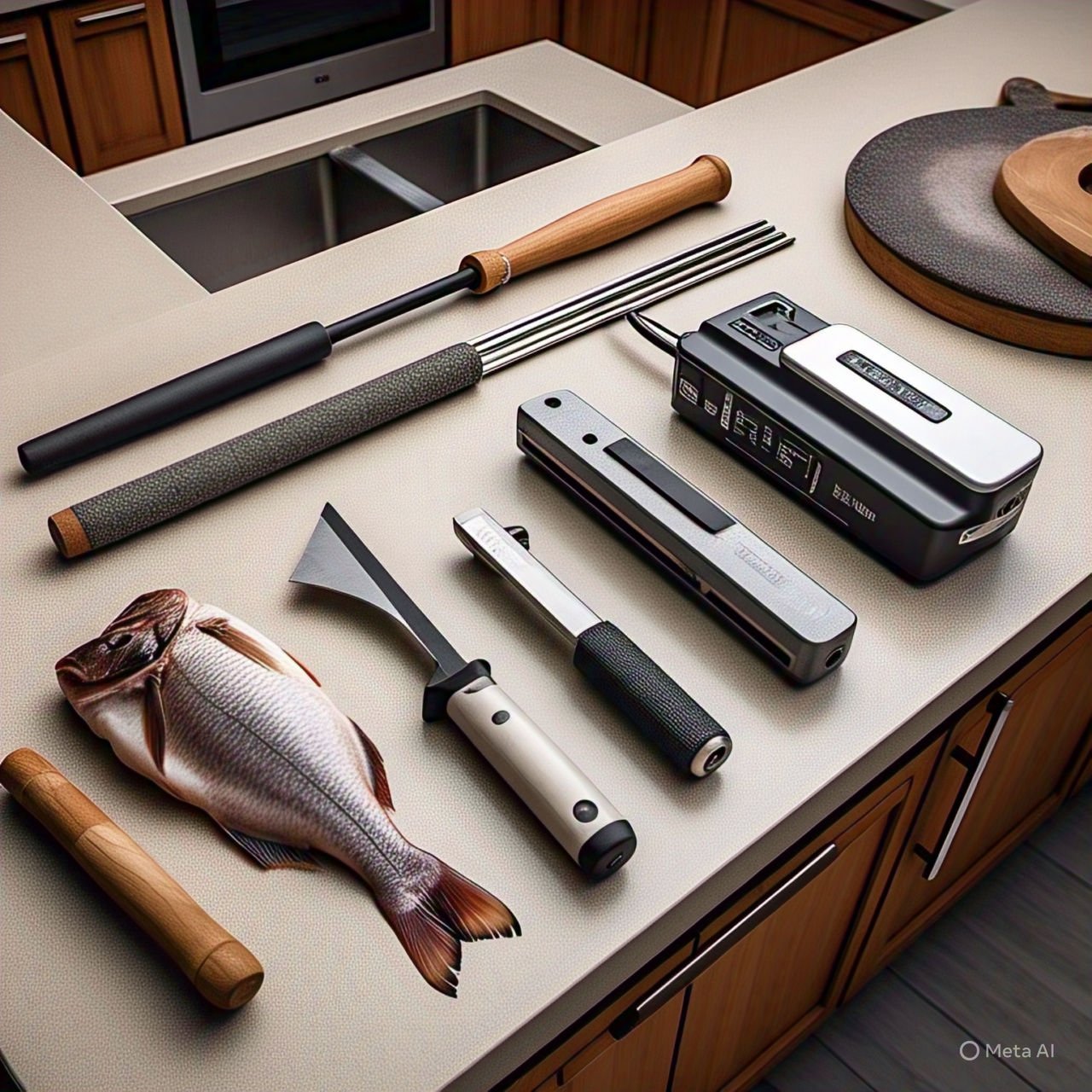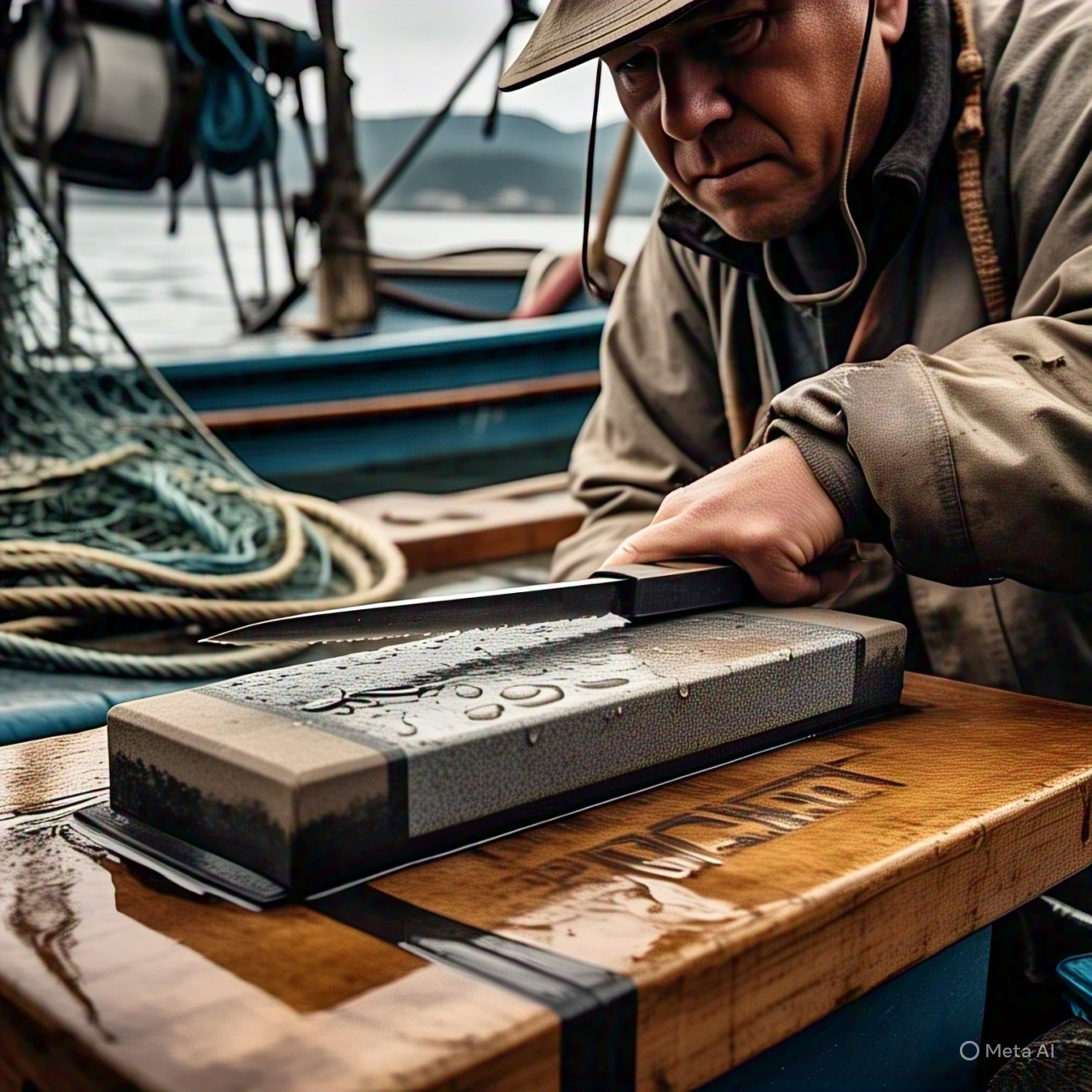As with any craft, having the right tools is crucial when filleting fish. If you want clean, precise slices every time, you need a sharp Best Fillet Knife Sharpener. Sharpness decreases with use, even in the best knives. Here is where the best fillet knife sharpener comes into play.
The Significance of Sharpening
-
Using a sharp fillet knife leads to cleaner cuts and less waste.
-
Dull blades provide a risk of injury and tearing fish.
-
A well-honed blade will extend the life of your knife.
-
By maintaining a clean edge, you can maintain the delicate texture of the fish.
Which Fillet Knife Sharpener Is the Best?
-
Specially designed for thin blades that are both flexible and strong.
-
Maintains a razor’s edge without risking injury.
-
Even a novice may operate it with ease and safety.
-
Resistant to corrosion, lightweight, and durable.
-
Durable enough to endure several sharpenings without reducing the blade’s useful life.
Types of Fillet Knife Sharpeners
1. Stones for Sharpening (Whetstones)
-
You may find grit in the fine (3,000–8,000) to coarse (200–400) range.
-
Gives you the most command, but it requires a high level of skill.
-
Apt for experts who value precision.
-
Oil and water stones are equally effective.
2. Ceramic Rod Sharpeners
-
An option for flexible fillet blades.
-
Appears often in clusters of many rods.
-
Perfect for quick touch-ups as needed.
-
Small and perfect for use in the great outdoors.
3. Files That Can Be Sharpened by Pulling
-
Simple, fast, and easy to understand and use.
-
You may get coarse, medium, and fine phases from some of them.
-
Handy, but it doesn’t quite measure up.
-
The blade may get dull after prolonged use.
4. Knife Electric Sharpeners
-
Simple and efficient.
-
Comes with a plethora of angle guides and sharpness levels.
-
Not as portable, but ideal for domestic kitchens.
-
It could be too sharp for filé knives that are very thin.
A Review of the Pros and Cons of Each Type of Sharpener
| Type | Pros | Cons |
|---|---|---|
| Whetstone | Time and skill are necessary for superior accuracy and durability. | – |
| Ceramic Rod | Rapid, on-the-go, and mildly abrasive. | Do not use on very dull blades. |
| Pull-Through | Angles are not consistent, secure, and straightforward. | The lifetime of the blade may be reduced over time. |
| Electric | Simple and fast, even for newcomers. | Less command and not travel-friendly. |
Most Important Features of Top-Notch Angle Guides for Sharpening Fillet Knives
-
Keep to a consistent routine for sharpening.
-
The non-slip base ensures stability when sharpening.
-
The design is quite portable, making it ideal for fishing trips.
-
Type of Grit: Coarse for shaping, fine for polishing.
-
Waterproof: Essential for use on boats or in the great outdoors.
-
Housing made of tough plastic, ceramic, or stainless steel for long-term durability.
How to Sharpen Fillet Knives with the Whetstone Method
-
Keep the whetstone submerged in water for at least ten to fifteen minutes.
-
Place it on a surface that won’t slide or use a holder.
-
Handle the knife at an angle of fifteen to twenty degrees.
-
Smoothly glide the blade across the stone from side to side.
-
Gradually go up from coarse to fine grit.
-
Rinse the stone and blade after each use.
-
A ceramic strop or rod may be used to provide a smooth finish.
Tips for Achieving Optimal Sharpening
-
Stay out of the tool’s way; it will do the work.
-
Be careful to use smooth, consistent strokes.
-
Keep the blade’s edge sharp on both ends at all times.
-
To assess the sharpness, cut a piece of paper or tomato peel.
-
Make sure to clean the sharpener after every usage.
The Importance of Having Dedicated Fillet Knife Sharpeners
-
For thin, bendable blades, a sharp edge is essential.
-
Normal kitchen sharpeners might hurt them.
-
Precision is of the utmost importance, especially when filleting delicate fish.
-
A high-quality fillet knife sharpener will keep the blade’s shape and pliability.
Advice on Maintaining and Sharpening Tools
-
Wipe clean after each use.
-
Keep in a dry place to avoid corrosion.
-
Replace broken rods or stones.
-
Using flattening stones, whetstones may be leveled.
-
No debris should be allowed near pull-through devices.
The Recommended Fillet Knife Sharpeners by the Year 2025
1. FishMaster Pro Whetstone Kit with Two Grit Options: 1000 and 6000
-
Came with a non-slip base and a measuring tool for angles.
-
Durable, compact, and ideal for travel.
-
For the most dedicated chefs and anglers.
2. The SharpenX Ceramic Rod Set
-
Comes with both fine and superfine rods.
-
The fillet knife is the tool.
-
Has a solid container for storing it in.
-
Perfect for honing when traveling.
3. EdgeTrek Pull-Through Sharpener
-
There are three steps: coarse, medium, and fine.
-
Coordinate systems for angles.
-
Solid base, easy for beginners.
-
Intended for swiftly honing a kitchen knife.
Expert Recommendations for Making a Fillet Knife Sharper
-
Sharpening chemical is used for a final polish.
-
Monthly sharpening and weekly honing are recommended.
-
Use fish-safe lubricants to prevent corrosion.
-
If you want your knife to last as long as possible, you should avoid oversharpening it.
-
The results are better when the angles are correct.
📊 Expense Guide: What Is the Recommended Amount?
You Get What You Pay For
-
A basic rod or whetstone without accessories might cost $20 to $30.
-
Mid-range set with carrying bag and instructions: $40 to $60.
-
The price range for a professional set with a variety of grit stones is $70 to $120.
Here’s some advice: decide whether you’re filleting at home or outside and how often you do it.

Sustainable Approaches to Edge Refinement
-
Try using a manual sharpener instead of an electric one.
-
Durable rods and stones may be reused for a long time.
-
Less waste generation.
-
It doesn’t need power or a battery.
-
Some kits include materials that may be recycled or broken down into smaller pieces.
-
If you know what you’re doing, the best fillet knife sharpener is better for the environment and your knives.
🛒 Where to Find the Best Fillet Knife Sharpener
-
Amazon: Find the top fillet knife sharpener and read reviews written by actual customers.
-
Fishing Equipment Stores: Businesses that serve the needs of fisherman.
-
Kitchen Supply Stores: Including Japanese whetstones and other expert tools.
-
Brand Websites: Warranty information and instructions.
-
Outdoor Merchants: Portable sharpeners for outdoor use.
Support and a 100% Satisfaction Promise
-
Look for one-year or longer guarantees.
-
Choose companies that can quickly replace employees.
-
Get some help honing your skills or enroll in some online classes.
-
Keep track of your invoice or items by registering them.
-
Make sure you read the reviews before you buy it.
Give It a Shot
-
To get nice slices, try using tomato peel or paper.
-
Rinse and resharpen or hone if tearing happens.
-
It ought to be easy for the blade to cut.
-
With the right honing, a fillet knife cuts like butter.
Important Practical Items to Consider
-
A leather strop along with polishing compound.
-
Applying angle guides will provide a stable edge.
-
Flattening plates using a whetstone.
-
Use a storage container to store everything in one place.
-
Suitable for use with silicone or non-slip mats.
-
Cleaning cloths made of microfiber.
These accessories will allow you to get the most out of the best fillet knife sharpener on the market.
A Common Mistake That Has to Be Avoided
-
Sharpening at the wrong angle.
-
Disregarding the fine grit level.
-
Use of too much force.
-
Unable to match the speed of your machinery.
-
Leaving the burrs on the blade uncleaned.
Angles for Sharpening
-
Western Blade Fillet Knife: 17 to 20 degrees.
-
Japanese Blades: 15–17°.
-
Use sharpeners that have angle guides or preset angles.
-
The use of correct angles leads to cleaner cuts and longer-lasting edges.
First-Held Testimonials
“This kit made my fish cuts smoother and faster!”
“Love the portability of the ceramic rod—it’s perfect for my boat trips.”
“Pull-through sharpeners are easy, but whetstones give the best results.”
Reviews written by actual customers are a great indicator of which fillet knife sharpener is the best.
Final Thoughts
To ensure clean slices every time, keep your fillet knife sharp.
Choose the best fillet knife sharpener for your needs, whether you’re at home, on the water, or in a commercial kitchen.
Consider portability, grit range, and accuracy of angle.
Regular maintenance guarantees optimal performance throughout time.
A sharp knife makes every filleting session easier, faster, and more fun.
